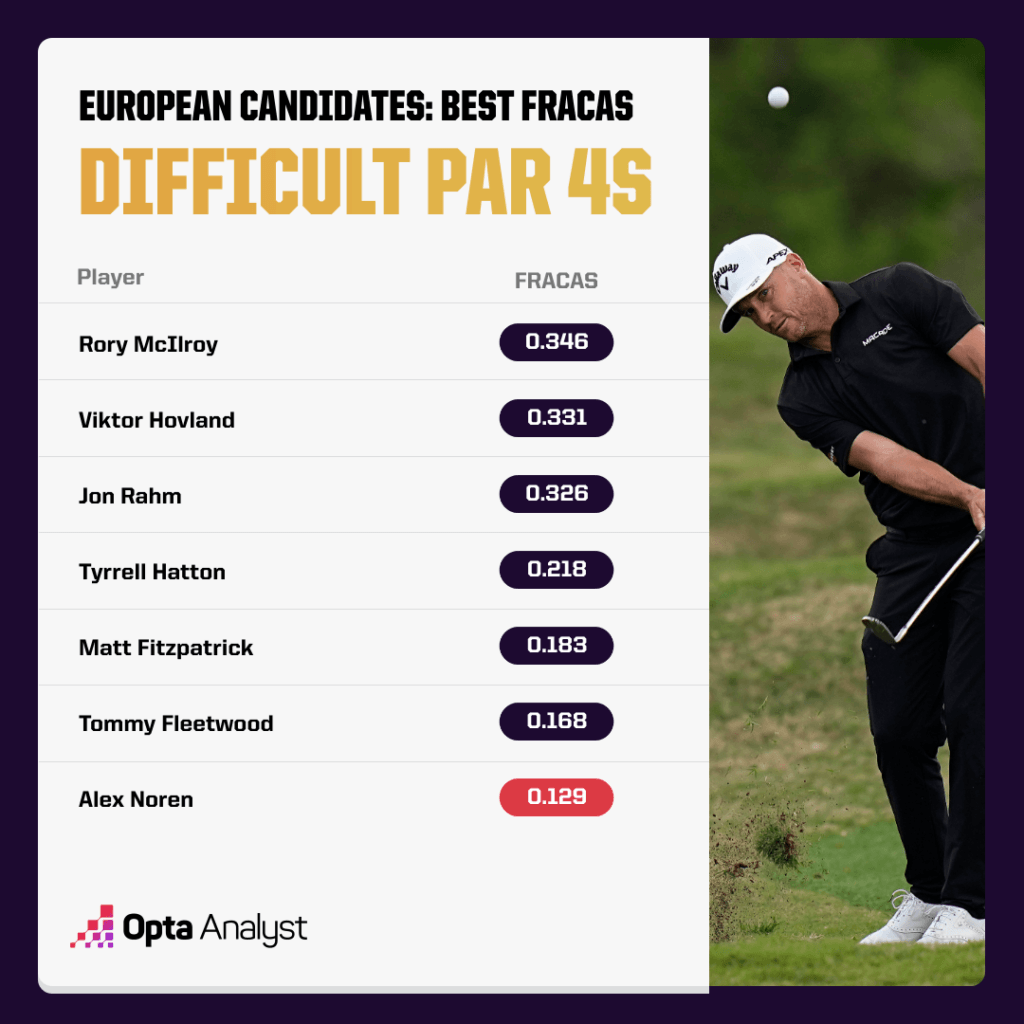The Ryder Cup, held in September at Marco Simone Golf & Country Club in Rome, Italy, looms as a home game for the European team.
Normally, playing on the road spells doom for the Americans. Team USA, as every broadcaster will remind you during the tournament, will be looking to win a Ryder Cup on European soil for the first time since 1993 – before a bunch of the players now teeing it up for both sides were even born.
The Americans have taken trans-Atlantic drubbing after drubbing in the match-play event from tight-knit European teams led by the likes of Sergio Garcia, Ian Poulter, Lee Westwood, Justin Rose and Rory McIlroy. Times might be shifting, though. The U.S. Team’s win at Whistling Straits in Wisconsin in 2021 by a 19-9 point margin was one of the most lopsided ever.
As Team Europe’s veteran stars have faded out of the sport or gone to LIV Golf, the Americans have accumulated a talent advantage. The six automatic qualifiers for Team USA all rank among the top 11 on the world points list – Scottie Scheffler, Patrick Cantlay, Xander Schauffele, Max Homa, Brian Harman and Wyndham Clark.
The Americans could take as many as 11 of the top 20 golfers in the Official World Golf ranking on their 12-man roster, including Jordan Spieth, Collin Morikawa, Brooks Koepka, Tony Finau, Cameron Young and Keegan Bradley. The Europeans will have three of the top five in Rory McIlroy, Jon Rahm and Viktor Hovland, but the team’s depth after that world-beating trio is an open question.
So it’ll be especially imperative that team captain Luke Donald nails his six captain’s picks. Those players will join Europe’s six automatic qualifiers: McIlroy, Rahm and Hovland (who just won the BMW PGA Championship in August) clinched spots weeks ago. Englishmen Tyrrell Hatton joined them when the dust settled on the Tour Championship on Sunday, and Robert MacIntyre and Tommy Fleetwood are in a strong position to clinch spots with one week left on the European tournament calendar.
Donald’s decision time is nearly here. Here’s who he should bring, based on our FRACAS model and detailed course and statistical data.
Matt Fitzpatrick, England
Meet the easiest pick of all. Fitzpatrick narrowly missed auto-qualifying but will be a critical part of the team. The 2022 U.S. Open winner is 19th in the world in FRACAS, our course-adjusted strokes-gained measurement, and he was one of the best players on the PGA Tour all season. Fitzpatrick is unyieldingly consistent, and he’s gotten comfortable winning tournaments against the best players in the world. His 0-5 record in Ryder Cup matches between 2016-21 should soon improve.
Justin Rose, England
Here’s another very near no-brainer for Donald. Rose had a quiet year; he won at the AT&T Pebble Beach Pro-Am in February, beating out a solid but unspectacular field in a non-designated PGA Tour event. He tied for fourth at the British Masters, his lone DP World Tour appearance, and scattered a few other top-10 finishes between May and the early summer. He missed the cut in back-to-back weeks in Scotland and the British Open in July. Yet Rose, at 43, still has good form. He’s seventh among Europeans with a 1.092 FRACAS, gaining more than a stroke per round on the field. He’s one of the best in the world at cruising around a tough course and making pars: Our course-fit data estimates he’ll achieve a score of par or better on 75.59% of his holes at Marco Simone, also seventh among European options. He’s fifth in estimated birdie-or-better percentage (19.65). Rose is sharp on long, difficult par 4s, with a 0.160 FRACAS on those vexing layouts, making him a must-take for his captain.
Shane Lowry, Ireland
The 2019 Open champion made very little noise on the PGA Tour this year. His only top-five finish came when he tied for fifth at the deflated Honda Classic against a weak field. He otherwise didn’t get into a top 10 on any leaderboard, and he didn’t come that close to qualifying for the FedEx Cup Playoffs. (He finished 78th in the standings, where the top 70 qualify.) But Lowry’s game remains in better shape than his results showed. His 0.829 FRACAS places him 42nd in the world and eighth among Europeans, as does his 19.39% projected birdie-or-better rate at Marco Simone. Lowry scores better than the field on every hole classification on the FRACAS leaderboard: shorter, longer, easier and harder par 3s, 4s and 5s
Stephan Jaeger, Germany
Jaeger debuted on the PGA Tour in 2018, lost his tour card after 2019, and finally got back to the big stage in 2022. He hasn’t contended for wins, but he’s notched eight top-20 finishes in 29 starts and has generally been a bit better than the field average with a FRACAS of 0.680 per round. Like Lowry, he’s posted a positive FRACAS on every hole classification. He’s also a respectable driver of the golf ball, slotting 46th on tour driving distance (306.1 yards). Against an American lineup full of long-range bombers, Jaeger will be useful. In fourball competition, Donald can pair him up with a steady partner and let Jaeger, whose 424 birdies this season were second on tour, hunt for flagsticks.
Alex Noren, Sweden
Noren has missed a ton of cuts this year (nine in total, including three of the four majors). But he’s been in better form since the beginning of July and has finished in the top 25 in two of his last three events, one of those being the Open, where he tied for 23rd. Noren went 2-1 for Europe in his lone Ryder Cup bid in 2018, but more importantly, he’s a good statistical fit for a course that demands excellence on long, brutal par 4s. The four hardest holes at Marco Simone are those par 4s between No. 8 and No. 15, where more than a third of players are likely to make bogey or worse. (About half make bogey, double, or triple on the 510-yard eighth.) Noren’s 0.129 FRACAS on long, hard par 4s is the best of any European outside of the team’s six best players (McIlroy, Rahm, Hovland, Fleetwood, Hatton and Fitzpatrick). Noren has generated almost no Ryder Cup buzz this time around and seems an unlikely pick, but based on his strengths and the course’s teeth, he would be a good one.

Adrian Meronk, Poland
Meronk is fifth on the European points list and has been highly competitive on the DP World Tour. He’s won twice this year, and one of those wins was at Marco Simone in the Italian Open in May. Meronk’s 0.343 FRACAS score makes him less of an analytical darling for this spot than some of his competitors, but he’s another consistent, solid pick who’s unlikely to cause Donald problems. He picks up strokes on the field on every hole classification except long par 3s, where a -0.020 FRACAS is barely below average, and where a strong partner can hide a relative weakness in every format except Sunday singles matches. Meronk hits 62.7% of his fairways, compared to a 58.5% DP World Tour average. His above-average accuracy will be handy if the Europeans do as they’re expected and ensure that Marco Simone’s fairways are mowed narrowly to penalize longer, riskier American tee shots.
What About Aberg?
The selections of Noren and Meronk don’t leave any room for maybe the most exciting potential pick the Europeans could make: Ludvig Aberg, the 23-year-old Swede who debuted on the PGA Tour this season and quickly became one of the tour’s longest hitters.
Aberg’s 0.477 FRACAS would put him right on the statistical bubble, but his figure when fitted to Marco Simone drops to 0.261 – in other words, suggesting he’s only about a quarter of a shot better per round than the average player on that course. Aberg, despite his 317-yard driving distance, has struggled with both longer par 3s and the long par 4s that characterize so much of Marco Simone.
Nonetheless, Donald might want to find room for him in the hopes that his length off the tee becomes an asset in fourballs, where a steadier veteran could pair with him. If Aberg isn’t an important part of the 2023 team, he’s likely to play a part in 2025 and beyond.
Like this? Follow us on Twitter for more.
